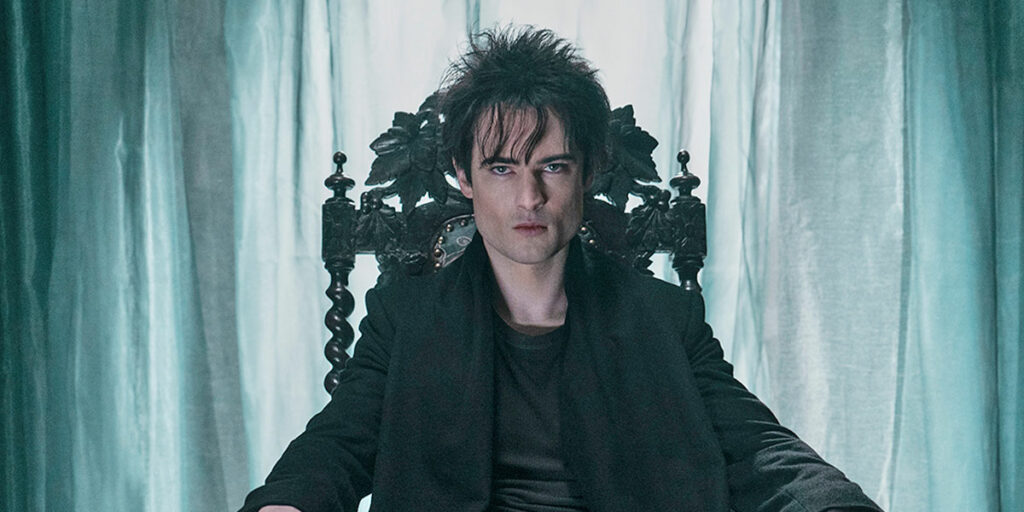The highly anticipated Netflix adaptation of The Sandman is here and it delivers, finally bringing to life Neil Gaiman ’s dreamy vision of his comic book series.
It is no surprise such a juggernaut of a company like Netflix is actively searching for their next big thing with Stranger Things — arguably their most valuable asset — nearing its end. Yes, we do know the Duffer Brothers have ideas for potential spin-offs, but it is hard to believe they will recapture the same magic from the original show, at least at the moment. In a report by Reuters, Matthew Thunell, vice president of Netflix, claims they are trying to find their own version of Star Wars or Harry Potter in an attempt to have a franchise that can help them transcend across the film, TV, video game, and merchandising industry.
From a business perspective, it makes sense for Netflix to be doing this, since they don’t have the luxury of being the only streaming service in town anymore and now they find themselves in a streaming war where the competition is constantly turning new subscribers their way. Of course, we have seen seeds of this plan of theirs after the announcement of several brand projects, following the success of The Witcher, The Gray Man, Bridgerton, and Red Notice. One more card Netflix seems to have under their sleeve is the incredibly influential comic book series by Neil Gaiman: The Sandman.
For three very long decades, Warner Bros. and DC comics have been trying to bring The Sandman to either the silver screen or the small screen. The project has been in development hell, from Neil Gaiman refusing to support the studio’s attempt to adapt his story in the early 1990s to writers, directors, and stars, such as Joseph Gordon-Levitt, dropping out of production due to creative differences a decade later. Netflix would eventually land the rights to adapt the property with Gaiman himself being heavily involved, steering the way to make sure the very first adaptation of his acclaimed work would be worthy of its name. The show is also executive produced by David S. Goyer, who was involved in the production process with Joseph Gordon-Levitt’s take on the project, and it’s being run by Allan Heinberg.
The Sandman is one of the Endless beings in the universe. They’re a family of anthropomorphic representations of powerful natural forces. Netflix’s adaptation follows one of the Endless, named Morpheus (Tom Sturridge, Irma Vep) — the King of Dreams, simply known as Dream or Sandman to some — as he escapes from imprisonment after being captured by a human wizard named Roderick Burgess (Charles Dance, The Crown). He tried to find and enslave Death (Kirby Howell-Baptiste, Hacks) — Dream’s older sister — but instead trapped the Sandman. From here, Morpheus embarks on a journey across worlds to find the tools that were stolen from him by his captors in order to restore his power and his realm of dreams and nightmares to what it once was.
Some spoilers for The Sandman ahead.
Episode 1: “Sleep of the Just”

Like any good fantasy series, The Sandman’s lore and scale is enormous, and Netflix’s adaptation wastes no time in establishing its rich visual style in episode 1, “Sleep of the Just.” Amongst so many impressive shots showcasing the series’ gorgeous cinematography and production design, the thing that stood out the most to me right off the bat is a one-shot of a raven traveling through (quite literally) space and time. This and Tom Sturridge’s narration as Morpheus in the pilot help establish what you’re about to venture into for the rest of the season, and makes such an intimidating thing to bring to the small screen accessible to those unfamiliar with the source material. Neil Gaiman — alongside Goyer and Heinberg — wrote the teleplay for the show’s premiere, and it’s only fitting for the creator of this universe to be the one to introduce a new generation of fans to these characters and world.
Episode 1 moves quite smoothly, setting up the main players of the show and the conflict at hand. You could argue some of the exposition and rules of the world can be hard to follow due to the nature and complexity of its themes and ideas the series is trying to explore, but you could say the same thing about the comics as well. The Sandman does not wait around for you to understand what it’s trying to say. It rather encourages you to be patient with its storytelling in hopes the characters will engage you enough to keep watching. This will end up benefiting the show in the long run as it might inspire viewers to go back and revisit the series in the future and discover all the depth they might have missed on their first viewing. This goes for the entirety of the show’s first season, not just the first episode.
The Sandman’s cast is impeccable. Even though he’s only in one episode, Charles Dance’s take on Roderick Burgess is a great example of the cast’s on screen presence. He is far more emotional than I could have imagined. On paper, Roderick is a man consumed by the thought of resurrecting his dead son through Death’s powers, driving him into becoming an extremist and leading him to neglect the family that’s still present. It could’ve been so easy to make him a one-dimensional character, but what Dance does with him, though, is reveal the desperation of Roderick and his paranoia. This is all he has left, or what he thinks is left of life, and the tragedy of his own blindness elevates Morpheus’ journey once he escapes from captivity. It’s not just a means to kick off the story, Roderick and his son Alex’s arcs serve a purpose to push somebody like Morpheus — a God-like creature — to see that humanity is capable of heinous things for love. This comes to play throughout the season as he has to learn that just because he saw the worst side of humanity during his imprisonment, it doesn’t mean everybody is like that.
Episode 2: “Imperfect Hosts”

The themes of the show only grow stronger as it continues. We have one of the looming threats of the series in The Corinthian (Boyd Holbrook, Vengeance) — a nightmare come to life created by Morpheus himself — as he challenges his creator for preventing him from freely traveling between the Dreaming and Waking world to murder and cause chaos. This in a sense can be interpreted as man going against their God’s own original design in order to do as one pleases. Obviously, the Corithian does go too far, he’s not necessarily meant to be a character to root for, but the questions he raises of how much of our actions are done by design and how much by choice are still presented in quite a profound manner.
This is later paired with Abel (Asim Chaudhry, The Electrical Life of Louis Wain) and Cain’s (Sanjeev Bhaskar, Yesterday) storyline in episode 2, “Imperfect Hosts,” where Morpheus asks them to offer him their pet gargoyle named Gregory as a sacrifice in an attempt to help him regain some of his power. Not only does this work as a metaphor of the kind of things we are willing to forgive the Gods we choose to believe in, but Abel and Cain’s story — clearly inspired by the biblical tale of the first murder, with a twisted sense of humor — is one that challenge us to think about the cycle of life, death and rebirth.
Episode 3: “Dream A Little Dream of Me”
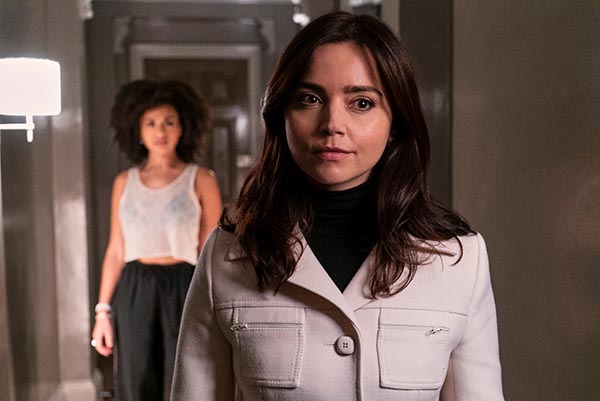
Somebody who we definitely have to talk about is Jenna Coleman’s (The Serpent) portrayal of Johanna Constantine. We could touch on the controversy surrounding the gender-swap characterization of John Constantine, but I would much rather focus on what we have on screen, which is pure genius. I don’t think I am exaggerating when I say nobody has been able to capture the essence of the character as perfectly as Coleman has. She’s fierce, but funny with a non-caring attitude that makes her so damn likable. Her introduction, as she is performing an exorcism in the middle of a wedding, is already one of the most iconic moments of the show in my mind. Johanna’s relationship with Morpheus is captivating as well, as they’re more alike than they care to admit. Episode 3, “Dream a Little Dream of Me,” in particular does a lot to advance both of their characters’ arcs. On one hand, the episode feels like it’s setting up a potential Johanna Constantine spin-off, since Jenna Coleman could easily carry her own show, but that’s not all.
The episode also touches on the themes of vulnerability and being okay with asking for help and relying on others. Closing yourself from your loved ones won’t protect them from harm’s way, which Johanna learns the hard way as she helps Morpheus recover his pouch of sand, which she leaves at his ex-girlfriend Rachel’s (Eleanor Fanyinka, Endeavour) house. It is too late for Rachel, though, as the sand has consumed her, forcing Dream to give her a quick death. It’s in this episode where we’re introduced to Matthew the Raven (Patton Oswalt, The Boys) as well, a man who after death was reincarnated as a raven and becomes Morpheus’ loyal companion.
Episode 4: “A Hope In Hell”
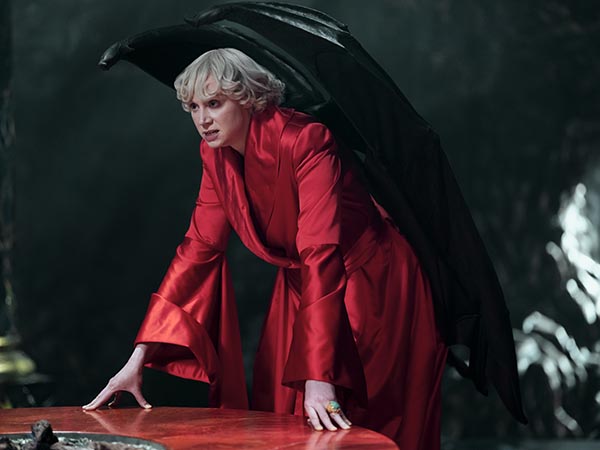
With his leather pouch of sand back in his possession, it is time for Dream and Matthew to travel to hell and pay Lucifer (Gwendoline Christie, Game of Thrones) a visit in an attempt to retreat the Sandman’s helm. Patton Oswalt as Matthew the Raven is sort of a mixed bag. Is not that his acting is bad, but the fact that his voice is so recognizable takes you out of the narrative half of the time he’s on screen. I think Oswalt’s performance in episode 4, “A Hope in Hell,” is what sold me on his portrayal of the witty sidekick. Sure, he’s the comedic relief, but his genuine sense of wonder and the care he develops for Dream is too pure to not like. And although episode 4 is not the strongest of season one on a thematic standpoint, it’s still compelling as Dream starts to open himself up emotionally.
On their journey to have an audience with Lucifer, Matthew and Morpheus encounter an imprisoned woman named Nada (Deborah Oyelade), who we later learn used to be Dream’s lover whom he sent to hell after she rejected to be his Queen. As a result, we begin to see just how flawed Morpheus really is, showcasing he is capable of love just as the humans he tries to separate himself from. To touch on Gwendoline Christie’s Lucifer for a moment, she is as charismatic and intimidating as you would expect. She sells the essence of being a fallen angel so perfectly with her sarcastic way of speaking. The duel of riddles she has against Dream is just as good as what’s on the page. It’s quiet, eerie, visually pleasing to witness, and advances Morpheus’ status quo amongst the universe in quite a simplistic way.
Episode 5: “24/7”

Don’t be misled by all of the spectacle The Sandman carries on its back. The show shines the most when its focus is on the writing, its minor characters and their monologues. Netflix’s adaptation of Gaiman’s classic already has some of my favorite hours of television in the entire year with episode 5 “24/7” and episode 6 “The Sound of Her Wings.” The former is a raw, mean, yet honest look at humanity’s relationship with lies and dreams. From the first episode up to episode 5, The Sandman has been building up a confrontation with the villainous John Dee (David Thewlis, Landscapers) — the last living son of Roderick Burgess and Ethel Cripps (Joely Richardson, The Turning) — who has come to have Morpheus’ ruby in his possession. What’s interesting about John is that in a way he parallels Dream. Both being imprisoned for their “gifts” and once they are freed they seek to restore the world to their own liking. John Dee, unlike Morpheus, is insane and has grown obsessed with the idea of freeing the world from lies after his own mother kept the identity of his father hidden from him.
For almost its entire runtime, episode 5 takes place at a diner where we see every-day people become victims of John’s as he forces them to be honest with themselves and their loved ones, no matter the harm that might cause them in the long run. This is where once again Neil Gaiman’s brilliant themes come to fruition. Whereas John is desperate for people to be honest with themselves, even if this turns them into violent and selfish individuals, Dream views humanity’s desire to dream for a better future as far more important than the actual truth. Should we show the world our true colors, or is living in a hopeful fantasy a better alternative? These kinds of questions are what makes The Sandman so compelling and unique, far better than most Netflix productions at the moment.
Episode 6: “The Sound of Her Wings”
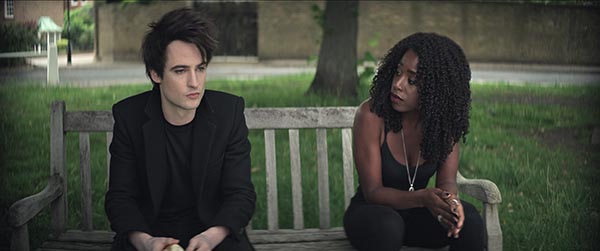
Then we have episode 6, where we finally meet Dream’s sister, Death. Like “24/7,” this episode is far more interested in asking rich questions about mortality than in epic action. The advantage of adapting Gaiman’s work is that his characterization of old tropes aren’t boring or cliché. For example, in the media we usually present somebody like Death as a scary, heartless entity that’s more of a threat to life than something we should welcome with open arms. Not in The Sandman, though. Here we see Death as a kind, understanding, sensitive and sympathetic other-worldly being that cares for the people she swore to serve. I can say with confidence that Kirby Howell-Baptiste’s Death is the breakout star of the series. Her charisma is unmatched and her line delivery is electric, yet calming in a sense, especially when Death visits a human person because their time is up and they have to leave the world of the living. Baptiste’s chemistry with Sturridge’s Dream is utterly special as well. Through Death, Morpheus opens himself even more at the thought that he and the Endless exist to serve humanity, not the other way around, and to appreciate the beauty of just how flawed people really are.
During this episode, we also see a friendship blossom between Dream and a human named Hob (Ferdinand Kingsley, Mank), whom Morpheus grants the gift of immortality in a twisted experiment where Dream seeks to figure out why humans yearn for life as much as we do. Through Hob’s storyline, we are once again challenged. Why are we so scared of death? Why do we think we deserve another chance at life as opposed to others? What makes us so special when it seems we just live the same life on a never ending cycle? Having these questions presented to the audience right after going on a journey with Death about embracing our inevitable end is quite beautiful because we see both sides of the argument. Why we should be given another shot at life, but also why it’s okay to know when to stop. This advances Morpheus’ arc as well as he is forced to finally admit that he, too, wants to know what being human is like as he yearns for friendship and human connections.
The Vortex Arc (Episodes 7-10)
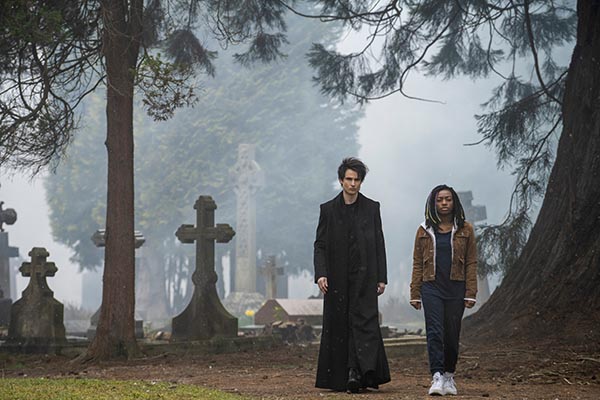
The Sandman’s first six episodes feel like each is trying to tell an individual story while interconnecting them to a much larger narrative. Personally, I love when TV shows do this because it allows the audience to pick which stories resonate with them the most without their opinion being affected by those episodes they might have not enjoyed as much. Perhaps this is why the last four episodes of the series didn’t do much for me. Don’t get me wrong, they’re still fantastic in their own right, but compared to earlier entries in the season where each episode had a beginning, middle and end, the second half of the show takes quite a bit to get you invested. To give you an idea of what these episodes are about, The Corinthian and Morheus learn about the existence of Rose Walker (Vanesu Samunyai) — a young woman searching for her missing brother Jed (Eddie Karanja) — who might be the one responsible to destroy the universe since she’s unknowingly a Dream Vortex.
We’re introduced to a variety of different colorful characters throughout the run of these episodes and for what is worth everybody has their moments to shine. To highlight a few, Samunyai and Karanja’s bond as the Walker siblings is a tragic one that immediately makes you root for them to succeed in their own personal journey. Then there’s Unity Kincaid (Sandra James-Young, His Dark Materials) — Rose and Jed’s long lost grandma — who brings a much needed warmth to the human characters with her sincerity and sweetness. And I can’t forget the gentle giant Gilbert (Stephen Fry, Heartstopper) — also known as Fiddler’s Green in the Dreaming world — as he becomes Rose’s protector and voice of reason. Also, somebody I forgot to mention earlier who has a pretty significant role to play in Dream’s arc is Vivienne Acheampong’s (The Witches) Lucienne. She’s the chief librarian of the Dreaming world and Morpheus’ most loyal servant as she was the only one who didn’t abandon her post when Dream was gone during the time of his imprisonment. Acheampong radiates wit and the subtleties in her performance allow us to see that this is a woman who’s seen a lot and might be better fit to be in charge, even more so than Dream himself in some occasions.
The way the show actually comes to a conclusion is rather simple and quiet, in good-old The Sandman fashion. Morpheus manages to overcome his obstacles and save the universe not by defeating a great evil, but by having an in-depth conversation with Rose, Unity, and those who she cares about. And by the time The Corinthian’s storyline comes to an end, you can’t help but miss Holbrook’s twisted charisma. But his spot is not left empty for long as Dream’s sibling Desire (Mason Alexander Park, Cowboy Bebop) comes into the forefront when his role in the narrative is revealed to us. Park is devilishly delicious as Desire. It’s a shame we don’t spend as much time with the other members of the Endless family because the show could have really used more of their energy. What we do get from them is excellent, though, and a testament to how well each character was cast. The actors fit their roles like a glove. There are also exciting set ups for future conflicts in following seasons, clearly trying to establish The Sandman as a sustaining franchise.
Neil Gaiman’s Views on Humanity
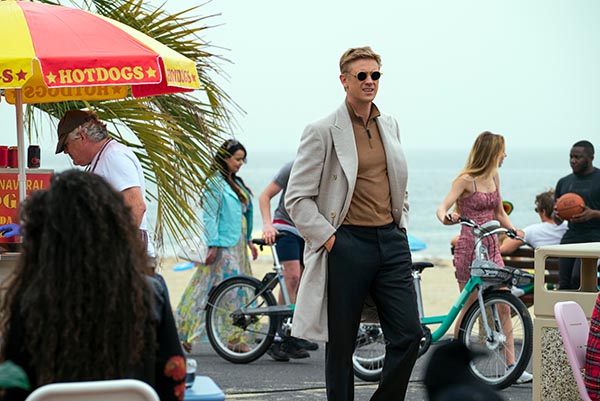
If you’re looking for a world to immerse yourself that will challenge you on a philosophical level, then look no further than Neil Gaiman’s The Sandman. As somebody who was familiar with the story through the Audible production of the graphic novels that was developed just a couple years prior to the series, I still found myself surprised by how well Netflix was able to pull this off. This feels like one of those rare cases where the right people were paired with the right project to come together and create something special. You an see every tiny little detail that was put into The Sandman was taken cared of with so much care and love. I have to bring up the cinematography again because it can’t be said enough just how epic it is, while being intimate at the same time. Composer David Buckley goes up and beyond to make sure you feel every emotion the scripts and the actors want you to feel with his original score. These three elements go hand-to-hand to balance out the spectacle and Gaiman’s themes, which take priority in his story.
For every random big budget piece of media that’s been released in the past decade, it is a nice change of pace to have something more challenging that forces you to ask yourself what you would do in the characters’ shoes in regards to such intimidating inquiries. Should you remain faithful to your God, even if he’s abandoned you or asked the impossible from you? What would be more damaging to our world, being truthful or lying to ourselves by living in our dreams? Is there a greater destiny awaiting us, or are they simply false fantasies? Why are we as living things so scared of death when we know it’s waiting for us at the end of our journeys? Neil Gaiman created an incredibly intelligent story about humanity that could have easily been misrepresented and turned into a shell of what it actually is. We are flawed individuals looking for our place in this world, and to see God-like entities figuring that out as well is quite humbling.
With Netflix’s well-recorded nature of canceling their own original series — despite critical success — who knows if The Sandman will be given the chance to prove itself in our current pop culture climate and be granted a second season. I just hope audience members open themselves to embrace such an unconventional, but smart fantasy epic. If The Sandman is any sign of where things could possibly go in Netflix’s future, then we might be moving into a brighter direction for the company.
The Sandman is now available to watch on Netflix.

